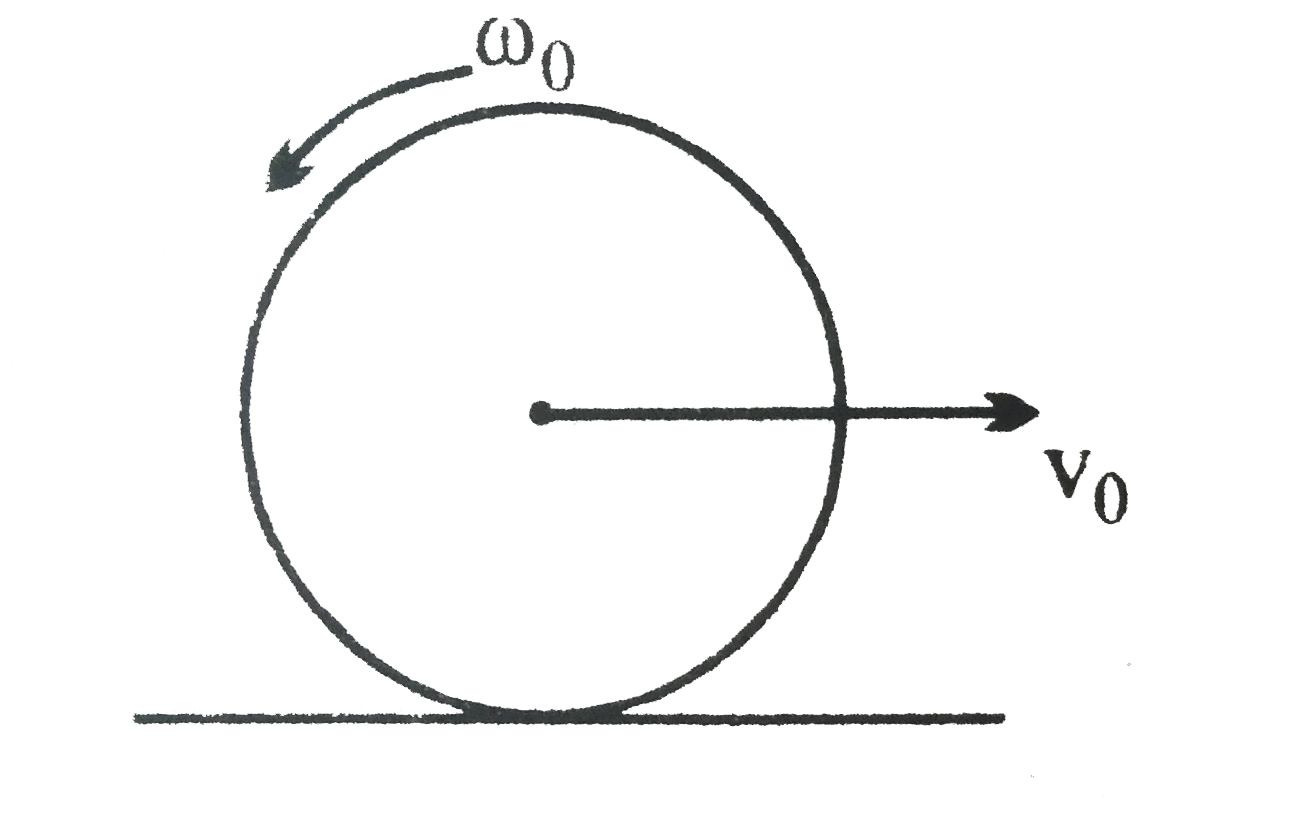A disc is given an angular velocity ω0 and a linear velocity v0 as shown in the figure. It is released on a rough horizontal surface of friction coefficient μ. Mark the correct statement (ω0=3v0/R) 
The frictional force will be μmg during the entire motion.
After some time the disc will start rolling without sliding along positive x-axis.
After some time the disc will start rolling without sliding along negative x-axis.
The mechnical energy of the disc will remain conserved.
The correct Answer is:C
Topper's Solved these Questions
- ROTATIONAL MOTIONBOOK - DC PANDEYCHAPTER - ROTATIONAL MOTIONEXERCISE - A Only One Option is Correct
86 Videos
- ROTATIONAL MOTIONBOOK - DC PANDEYCHAPTER - ROTATIONAL MOTIONEXERCISE - More than one option is correct
36 Videos
- ROTATIONAL MECHANICSBOOK - DC PANDEYCHAPTER - ROTATIONAL MECHANICSEXERCISE - Subjective Questions
2 Videos
- SEMICONDUCTORS AND ELECTRONIC DEVICESBOOK - DC PANDEYCHAPTER - SEMICONDUCTORS AND ELECTRONIC DEVICESEXERCISE - More than One Option is Correct
3 Videos
Similar Questions
A solid sphere of mass m and radiusr is given an initial angular velocity ω0 and a linear velocity v0=λrω0 from a point A on a rough horizontal surface .It is observed that the ball turns back and returens to the point A after some time if λ is less than a certain maximum value λ0 . Find λ0.

View SolutionA solid sphere of mass m and radiusr is given an initial angular velocity ω0 and a linear velocity v0=λrω0 from a point A on a rough horizontal surface .It is observed that the ball turns back and returens to the point A after some time if λ is less than a certain maximum value λ0 . Find λ0.

View Solution
Knowledge Check
A disc is given an initial angular velocity ω0 and placed on a rough horizontal surface as shown Fig. The quantities which will not depend on the coefficient of friction is/are
 Athe time until rolling beginsBthe displacement of the disc until rolling beginsCthe velocity when rolling beginsDthe work done by the force of friction
Athe time until rolling beginsBthe displacement of the disc until rolling beginsCthe velocity when rolling beginsDthe work done by the force of frictionA block of weight W is kept on a rough horizontal surface (friction coefficient μ). Two forces W/2 each are applied as shown in the choose the correct statement
 .AFor μ>√35 block will move .BFor μ<√35, work done by frictional force is zero in ground frame .CFor μ>√32 frictional force will do positive work (in ground frame) .DFor μ≤√32 block will move .
.AFor μ>√35 block will move .BFor μ<√35, work done by frictional force is zero in ground frame .CFor μ>√32 frictional force will do positive work (in ground frame) .DFor μ≤√32 block will move .A uniform circular disc placed on a rough horizontal surface has initially a velocity v0 and an angular velocity ω0 as shown in the figure. The disc comes to rest after moving some distance in the direction of motion. Then v0rω0 is.
 .A1/2B1C3/2D2
.A1/2B1C3/2D2
A disc is given an initial angular velocity ω0 and placed on a rough horizontal surface as shown Fig. The quantities which will not depend on the coefficient of friction is/are

View SolutionA uniform circular disc placed on a horizontal rough surface has initially a velocity v0 and an angular velocity ω0 as shown in the figure. The disc comes to rest after moving some distance in the direction of motion. Then v0/rω0 is :

View SolutionA uniform circular disc placed on a horizontal rough surface has initially a velocity v0 and an angular velocity ω0 as shown in the figure. The disc comes to rest after moving some distance in the direction of motion. Then v0/ω0 is :

View Solution
A disc of radius R has linear velocity v and angular velocity ω as shown in the figure. Given υ=rω find velocity of point A, B, C and D on the disc.
View SolutionA uniform circular disc placed on a horizontal rough surface has initially a velocity v0 and an angular velocity ω0 as shown in the figure. The disc comes to rest after moving some distance in the direction of motion. Then v0/ω0 is :

View Solution
